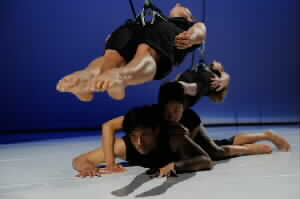White Spider: landscapes of the imagination

Mascal Dance's White Spider
Mascall Dance's "White Spider" is easily one of the most out-there performance experiences that I have had this year. The stage was equipped with a large revolving disk that was tilted on an angle and moved by a pneumatic lift. Climbing ropes hung from the ceiling, and on the back wall there was a contraption that looked like the ungainly offspring of a lightening rod and a basketball net (it turned out to be a dance/drawing machine). In the second act, a three-sided ladder-like structure was also wheeled onstage for dancers to climb and tumble on.
The title of the piece, "White Spider," comes from the book by mountaineer Heinrich Harrer, which details the many attempts to climb the notoriously dangerous north face of Switzerland's Eiger Mountain between 1935 and 1958.
In order to evoke 1930s climbing gear, Mascall Dance's six performers dressed like refugees from a Gap commercial: White cable-knit tank tops over white tennis shorts, mini khaki hiking-shorts and men's ties, argyle knee-socks and woolen tuques. One dancer, who played a sort of trickster role throughout the show, was dressed rather like a Go-go dancing Sherpa: white booty shorts, white gloves and tank-top, and a white fur-trimmed hat. Later she traded her fur-trimmed ankle boots for glittering stilettos, just in time to scale the stainless-steel ladders in her deadly footwear.
The eclectic costumes and bizarre set of "White Spider" were sure indicators to the audience that we weren't in Kansas anymore, and there would be no quick return to familiar terrain in this dance performance. The world on stage was a fantastic hallucination brought to life, and the performance that followed would only lead us deeper into its dangerous, storm-tossed depths.
Performers clipped into the hanging ropes and spun, rotated, leapt and fell from the beams of the “ladder.” They scaled the rotating disk, then tumbled off it in a tangle of intertwined limbs. They hung suspended mere inches from the floor, but their tortured convolutions seemed to transport them into mountain crevices high above the Earth. Video projections and voice-over narratives completed the illusion: mountain climbers hung off rock faces in the narratives, while dancers slipped and fell though the slats of the rocking ladder. The narrator described the deaths of climbers while dancers lay immobile on the floor, or rotated precariously on the disk.
Not only did Mascall Dance transform the stage, creating conceptual mountains for dancers to scale, but dancers' bodies became the arena for performance: as sounds of howling wind echoed through the room, dancers formed a human chain that trembled against its force. The voice-over described feats of impossible climbing, and the dancers traced the mountain climbers' paths on their own bodies – clavicle to shoulder, stomach to throat, mouth to eye to ear.
I'm always a little skeptical of performance that is gratuitously weird – it often seems like an easy way to get attention. In this case, however, there was something compelling about the lengths to which the company went to find fresh territory. "White Spider" does not simply dramatize its source material. Instead, the mountain-climbing theme is used as a conceptual base, a jumping-off point for human drama. There was comedy in the work: a dancer emerging from a kit-bag as if from a chrysalis, the same dancer sitting under a shower of empty water bottles falling like ice or scree from the face of the mountain. There was struggle and pain: a woman falling from a height of at least fifteen feet screaming uncontrollably, landing at the end of her rope mere inches from the floor. A figure dragging another by her ankle across the stage; a second figure hauled through the air by the cable gripped in her teeth.
The use of climbing ropes and the angled disk opened up possibilities for bodies in space. Those who were suspended from ropes where both more free and more constrained than usual. The could fly though the air and leap from platforms, yet they were always bound to a single point and could not escape it. Even when their bodies were limp they could not be at rest and swayed through the air. The climbing dancer seemed like a sort of fallen angel – superhuman but supremely vulnerable.
"White Spider" was certainly experimental, but its explorations were confidently and thoughtfully executed. I was surprised to find that the climbing ropes, though integral to the piece, were not the sole attraction. Dancers did as much work on the floor and the rotating disk (a very odd set piece) as they did on the ropes. The dancers did not abandon the vocabulary that they knew for the sake of a novel toy. Instead the ropes seemed like a new instrument in an process of kinetic investigation long underway. Dancers in "White Spider" seemed to defy gravity yet at every moment submitted to it, and the honesty of the performance lay in the precarious balance so achieved.
Mascall Dance in rehearsal for "White Spider": www.youtube.com/user/MascallDance#p/search/1/1muTYKh1aMI



